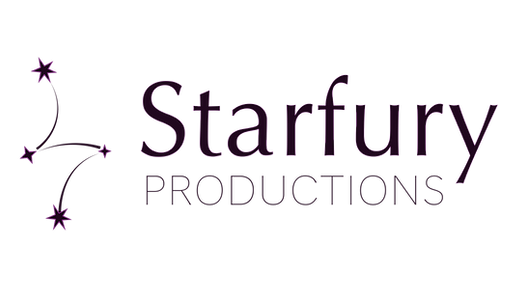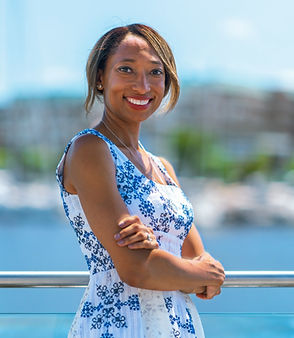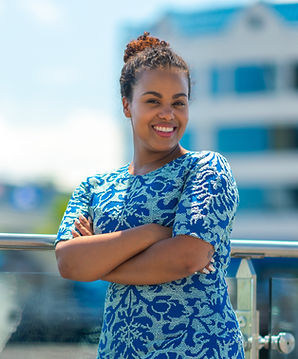( ENSPIRE Entertainment ) Co-Founders of Starfury Productions on the Underrepresentation of BIPOC Communities in the Entertainment Industry and Their Commitments to Telling BIPOC Stories
ENSPIRE Contributor: Sophia Kang
Last year, three Black storytellers launched a film and television development company called Starfury Productions. The term “starfury”, they write, stands for dream, drive, and growth, hence the stars in the company’s logo. For co-founder Nubia DuVall Wilson, a child sexual abuse survivor and sexual abuse advocate, the night sky was a reminder that “there was a bigger world out there for her—it saved her.” Starfury Productions emphasizes the starfury of Black and other BIPOC storytellers; since its founding, the company has dedicated itself to discovering, developing, and pitching impactful stories from underrepresented communities.
A recent McKinsey & Company study found that fewer Black stories get told in film and television, and those that do are “consistently underfunded and undervalued.” Black talent, the study’s authors write, remains significantly underrepresented in the entertainment industry. DuVall Wilson and Starfury Productions co-founders Guy Fortt and Oami “Naomi” Pandolfi are determined to change that.

ENSPIRE spoke with DuVall Wilson, Fortt, and Pandolfi about how they navigate the media and entertainment industries, how film and TV-watchers can demand more BIPOC representation on-screen, and what Starfury Productions is working on currently:
What are the challenges that come with navigating the media and entertainment industries as Black professionals?
NUBIA DUVALL WILSON: I have had the pleasure of experiencing the media industry from multiple perspectives. One experience was very eye-opening as an ex-pat living in Taipei, Taiwan, in my early 20s, after graduating from Barnard College. The questions I was asked from curious locals were a signal that their knowledge of Blacks was very one-dimensional thanks to our media. At least once a week, I was asked if I knew how to play basketball, breakdance, or rap. As much as I appreciate these disciplines and love that our people have brought them to the forefront worldwide, I did none of them (at least not very well or professionally!). I used those opportunities to show how multidimensional Black people are. We are more than those things and also have interests that are cross-cultural.
When I returned to New York City, I wanted to be a journalist. I had first-hand exposure to the lack of women and men of color in management roles at corporate media companies when I was hired by Time Inc. (bought by Meredith Corp.) I was proud that Real Simple Magazine, where I was an editorial assistant, had many women of color on staff. It gave me hope that I could move up the ranks, but I also noticed that the magazine’s content did not reflect the perspectives or images of its diverse team.
Thereafter, I became a publicist for luxury PR agencies. Most of the magazines I pitched that were not meant for “Black-only readers” rarely had any racial or ethnic diversity regarding a story’s stock photos, models in ads, experts quoted, or company profiles. The magazine/online media industry has changed a lot. I am happy that, from a corporate level, it is growing to be more inclusive of BIPOCs from internal company structures to consumer-facing content, and from an entrepreneurial standpoint, there are many new independent players who are filling the gaps (like ENSPIRE!).
GUY FORTT: African Americans are underrepresented in various facets of the media’s portrayal of the world. For example, although characters of color in video games have been increasing over time, Blacks are underrepresented significantly as playable characters. They are more likely to be stock characters in the story. Outside of sports games, the representation of African Americans drops significantly, with many of the remaining featured as gangsters and street people (Williams et al., 2009).
These systematically different experiences in the media market increase the need for more opportunities for African Americans and make it more challenging. We have to make sure Black workers have the same access to good jobs as white workers, and that there are new innovative approaches to shrinking the racial wealth gap.
OAMI “NAOMI” PANDOLFI: Over the course of my time working in the entertainment industry, there has always been a common throughline for BIPOC talent and creators: lack of opportunity, lack of representation, and lack of education on how the industry itself works. It was almost like there was some secret society of agingite groupers that had a secret formula that was only for them and theirs—except there isn’t actually a formula; they just made it up to exclude certain people from their reindeer games.
I can’t say that the earlier years of my career were particularly pleasant. There were disparaging comments, intentional misinformation, and setbacks. That all seemed to be directly related to racial stigma. To be honest, I’m surprised that I stuck it out and made it to where I am today, but that is the power of the drive to create. Artists and creators come in every shade, and the intensity of their passion doesn’t diminish with the rise of their melanin.

How can the rest of us, as film- and TV-watchers, demand more BIPOC representation on our screens?
DUVALL WILSON: We have to know our history foremost, and sadly, many Americans do not, which causes misunderstandings about marginalized communities from BIPOCs to those who identify as LGBTQ+. I was raised by Thomas Taiwo DuVall, who is a founding member of the Weusi Art Gallery, which he opened with his fellow artist friends in Harlem in 1965 as part of the Black Art Movement.
He is one of the few founding members still alive. The Weusi was the driving force behind the development, production, and distribution of Black art in the U.S. He made sure that I knew all the skeletons in our country’s closet when my schoolbooks and teachers glossed over them. It was a heavy load on a young girl’s shoulders, but it shaped me to be the hyper-aware person I am today.
Once you know the institutional plight of People of Color in America, you will be empowered to create change. From there, we must have decision-makers at the top who are racially and ethnically diverse in the media industry and focus on giving new voices a platform in the entertainment world. Put people over profits, and the money will come. Black Panther and Crazy Rich Asians are perfect examples that put a focus on Black and Asian leads and storylines and made millions (with Black Panther making $1.3 billion worldwide).
FORTT: The content our society views on screen is supposed to reflect its people. Still, all too often, the entertainment and media industries marginalize People of Color and women.
Media depicts stereotypical representations for People of Color and women, whether through Hollywood or on the news, as violent criminals, the help, submissive characters, highly sexualized beings, unintelligent people, and more. We will change that narrative by creating content that reflects the positive feelings of our history. Having diverse storytellers, actors, directors, and producers both on-screen and behind the scenes will no longer exclude diversity and inclusion in the entertainment and media industry. With all the many vehicles, like Hulu, Amazon, and other streaming services, to display our talents, the time is now to demand change, or we will create our own.
PANDOLFI: Be open to experiencing new thoughts and cultures in the content you watch. Ultimately, what we see on TV is in direct relation to what networks and studios believe will have the greatest financial return. Be on the lookout for new and diverse content, and be sure to watch it. The greatest power a viewer has is their eyes. Support the dreamers around you. Speak up about what you want to see on TV and in films—and what you don’t. Tweet at your favorite artists, networks, or studios, and let them know that you want to see more representation of marginalized communities in the content you watch.

What is Starfury Productions currently working on?
DUVALL WILSON: I am so proud of the projects we represent and develop, as well as the writers we are working with. We have a mix of scripted and unscripted projects, from humor and urban western to suspense and supernatural. I don’t want to pick favorites, ha ha, but I will say that the reason Naomi, Guy, and I connected was to develop and pitch my TV pilot for which Naomi and I are co-creators. The supernatural series raises awareness for post-traumatic stress disorder and the long-term effects of surviving sexual abuse. The TV and film business have long timelines, so as we continue to pitch that series, we are now joined by a handful of underrepresented creators who have impactful stories that we are developing and uplifting to get them optioned and sold. We want to be the trusted partners in production companies, networks, and streamers to provide them with engaging, entertaining content from voices that deserve to be heard but have had challenges breaking through. It’s inspiring.
FORTT: We have several fascinating projects, starting with a holiday film inspired by my personal story of overcoming tragedy and becoming triumphant when I was a young man after I witnessed my fiancé brutally murdered in our home. After that, I had a long road of recovery, taking me to Canada and back to Connecticut, where I became a firefighter, which ultimately led me to be an actor. We are currently developing a firefighter docuseries that I am very excited about. We are looking forward to this show being paramount in the entertainment space.
PANDOLFI: There are so many incredible and impactful projects on our docket right now. Honestly, everything is super exciting, but something that really has my interest right now is a fantastical/supernatural take on historical fiction. We have some fascinating projects in that vein. One that I’m currently developing is a supernatural historical thriller that’s sort of mash-up of Get Out and Abraham Lincoln: Vampire Hunter, about Polly Jackson, one of the lesser-known agents of the Underground Railroad who legendarily fought off slave-catchers with boiling water and a butcher’s knife. That’s only one of many extraordinary stories featuring BIPOC characters that we are working on. Bringing to life these obscure historical giants and making them larger than life with the power of film is such an amazing opportunity that I am so thankful to be a part of.

See Starfury Production’s current pitch listings here. Or pitch your own TV and film scripts to guystarfuryproductions@gmail.com.
Related Article: Anastasia Washington Breaks Barriers for BIPOC in the Entertainment Industry







